#and fim was made in canada so
Note
Do you know that Brian Drummond Vincent Tong and Ian Hanlin also in MLP not just Ashleigh Ball Shannon Chan-Kent and Kazumi Evans
I did, actually! afaik all of the main voice cast in prime (excluding deven mack) voiced in mlp at some point.
#chip answers#this is probably bc canada apparently has a thing about only casting canadian voice actors#and fim was made in canada so
0 notes
Text
Yet again, it's time to indulge in one of my favorite new year traditions: my ten favorite new-to-me films of 2023!
This is a wild, wild group of movies, but all of them got under my skin in one way or another and made this year that much brighter. If you like, consider this a strong endorsement for each of them.
Same rules as always: no movies from this past year (2023) or the year prior (2022). Every other year is fair game.

01. Jeanne Dielman, 23 Quai du Commerce, 1080 Bruxelles (dir. Chantal Akerman, 1975; Belgium/France; 202 mins.)
"I often cry when I think of you, Jeanne."
Sight & Sound's newly crowned Greatest Fim of All-Time was one of my first viewing experiences of 2023, and it loomed like a cloud over the rest of my moviegoing year. It was a bit of an ideal viewing experience - my favorite local independent theater had a showing, and the sizable audience was utterly enthralled by it. The massive Jeanne Dielman is a masterpiece in observation and behavior, and its power reveals itself through the way Akerman creates and unravels Jeanne's routine. She turns the lights off in every room she leaves. She replaces the lid of the money jar every single time. She watches her neighbor's baby for a little while in the afternoon. She looks presentable and pristine at all times, including after her sex work. When parts of these routines start shifting - the lid being left off the jar, the lights being left on for a bit too long, tousled hair - it plays like a jump scare.
I was shocked at how quickly this flew by. By the time the first day ended, I glanced at the time out of curiosity and was surprised to see it had already been an hour. Jeanne Dielman is a film that is frequently called "boring," which is both fair and entirely the point. It's still utterly mesmerizing within that boredom. This is thanks in large part to Delphine Seyrig's performance. With her hypernaturalistic stillness, Seyrig reaches rare levels of unaffected authenticity. Jeanne doesn't really feel like a character at all -- even with as little as we truly know about her, she feels like a human being.
Essential viewing. Long live the queen.
Currently streaming on the Criterion Channel and Max.

02. The Ascent (dir. Larisa Shepitko, 1977; Soviet Union; 111 mins.)
"Thanks for not leaving me. With company, it's... Okay, let's move on."
My final film in my 52 Films by Women challenge from a few years ago (shut up), Larisa Shepitko's The Ascent must be one of the greatest war movies ever made. Admittedly, it's not a genre I'm often drawn to, but Shepitko instills this film with an emotional power that becomes almost too much to bear.
Every act of cruelty, every gun fired, every open wound, is accompanied by a visceral pain. The way Shepitko uses the natural world as a stage for this story is astonishing - the vast snowy expanse of an unforgiving Russian winter, the rows of trees. Each of her actors manages to convey so much with their faces, too, especially the devastatingly good Lyudmila Polyakova, but the heart of the film is in the work of the two leads. Boris Plotnikov and Vladimir Gostyukhin work beautifully as a pair and as individuals. Shepitko masterfully traces the arc of their relationship against the backdrop of the war, and the end result is absolutely shattering.
The Ascent was, tragically, Shepitko's final film before she died in a car accident. It was my introduction to her as a filmmaker. I hope I can catch up with some of her earlier work, but The Ascent on its own is proof that she was a generational talent.
Currently streaming on the Criterion Channel.
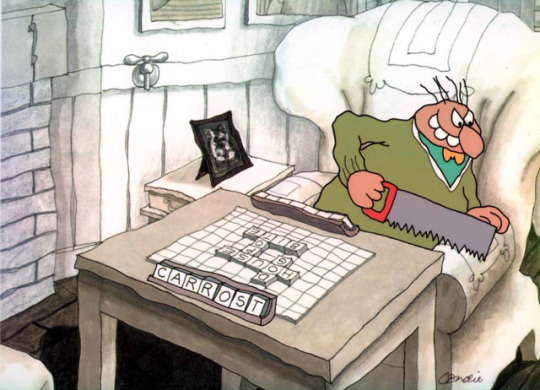
03. The Big Snit (dir. Richard Condie, 1985; Canada; 10 mins.)
"And stop sawing the table!!!"
Oh my God, I loved this so much? Other than being vaguely aware of the title and its good reputation, I had no expectations going into The Big Snit, but everything about it worked for me. The utterly bizarre sense of humor, the voice acting (especially the CAT?!), and Condie's deft combination of a marriage gone stale against the backdrop of nuclear anxiety make for a surprisingly moving ending. I think it might be a masterpiece of the form. And like Jeanne Dielman, it feels profoundly influential - it's easy to see the aftershocks of The Big Snit in a decade's worth of shows on Nickelodeon and Cartoon Network.
Currently streaming on the National Film Board of Canada's website.

04. Vagabond (dir. Agnès Varda, 1985; France; 105 mins.)
"I know little about her myself, but it seems to me she came from the sea."
There really was nobody like Agnès Varda. Vagabond, or Sans toit ni loi, if you prefer its evocative original title, is pretty handily the most emotionally devastating film of hers that I've seen. As Varda shows us Mona's journey through the French countryside, it's hard not to see shades of Wendy and Lucy or even Nomadland. Like the protagonists of those films, Mona struggles to keep her head above water while living on the margins of society, and, like Reichardt and Zhao, Varda manages to find the joyful, the beautiful, and the life-affirming underneath the hardship. She also coaxes stunning work out of Sandrine Bonnaire, who turns in an extraordinarily unaffected and naturalistic performance.
Vagabond's secret weapon might be in its structure. Marrying traditional narrative scenes with a documentary-like direct address, Varda creates an achingly realistic atmosphere. Her work as a documentarian is well-known, and as a bridge between narrative and documentary filmmaking, Vagabond may just be the crown jewel in Varda's expansive body of work.
Currently streaming on the Criterion Channel.

05. A.I. Artificial Intelligence (dir. Steven Spielberg, 2001; USA; 146 mins.)
"And for the first time in his life, he went to that place where dreams are born."
Weepy existential sci-fi remains undefeated!
A.I. Artificial Intelligence is undeniably a huge swing. Genuinely feeling like that impossible mix between Spielberg's and Kubrick's sensibilities, A.I. achieves something of a hat trick - a fairytale steeped in existentialism. The Pinocchio comparisons are immediate and on-the-nose, but that doesn't make it any less fertile grounds for a compelling story. There's so much in this film that physically hurts the heart and the head to think about for too long - so much grief, so much cruelty - that framing it around David's immediately accessible journey toward becoming a real boy is pretty ingenious.
Of course, this film, maybe more than any of Spielberg's others, is deeply reliant on its lead performance. Haley Joel Osment is astonishing in this film, a blank slate for an entire world's love and anguish to project itself. Without him, the film would probably still be a fascinating sci-fi epic, but Osment lends the film the bulk of its emotional power. If we don't believe that David's entire reason for being comes from his need for love from his adopted mother (which, admittedly, is a pretty thin clothesline for the film's heavy plot to hang on), then we don't care. Osment makes us care. From anybody, this performance would be a triumph, but from a 12-year-old? It might be one of the miracles of acting.
Available to rent on demand.

06. Humanity and Paper Balloons (dir. Sadao Yamanaka, 1937; Japan; 86 mins.)
"How could he kill himself on such a nice day? How utterly selfish of him."
Up until watching this film, I don't think I ever paid any special attention to Sadao Yamanaka's name. Within a year of the release of Humanity and Paper Balloons, the 28-year-old Yamanaka would be dead.
His untimely death only hints at the kinds of films he could have made with more time. This, though, is surely one of the finest (and most depressing) final films I can think of. One of the great strengths of Humanity and Paper Balloons is how startlingly modern it all feels: it's a 1930s drama, yes, but Yamanaka's thoughtful, assured direction really brings the poetic and tragic script (written beautifully by Shintaro Mimura) and performances (especially Kanemon Nakamura as Shinza the hairdresser) to life. Like the best tragedies, the events of Humanity and Paper Balloons feel senselessly cruel and brutally inevitable, but unlike other tragedies, Yamanaka is careful to keep just a bit of disarming humor to prevent the film from feeling too heavy.
It's an incredibly sad story beautifully told by a filmmaker struck down in his prime. Extremely worth a watch.
Currently streaming on the Criterion Channel.

07. Mississippi Masala (dir. Mira Nair, 1991; USA; 118 mins.)
"Home is where the heart is. And my heart is with you."
There is so much in Mississippi Masala that's wonderful. There's the beautiful young couple at the center, Sarita Choudhury (in a lovely debut performance) and Denzel Washington (a few years after his first Oscar win), who are so hot together that it feels like the TV might catch on fire. There's the supporting cast, too, including the legendary Sharmila Tagore, the great Charles S. Dutton, and the soulful Roshan Seth, whose sad, exhausted face is the heart of the film. There's the sensitive script by Sooni Taraporevala, that somehow finds an intimate romantic drama in a sprawling story that includes the Indian exodus from Uganda, an immigrant family's assimilation into the American South, and two clearly defined family dramas in vastly marginalized communities.
Perhaps most wonderful is Nair's gorgeous direction. The film has an expressive, vibrant visual palette, with so many different shades of red accompanying Mina and Demetrius' blooming romance. This is a rich, sensual film, and one of the great romantic dramas of the 90s.
Currently streaming on the Criterion Channel.

08. Lingua Franca (dir. Isabel Sandoval, 2019; Philippines/USA; 95 mins.)
"It doesn't matter where I go. They will hunt me down, and take me away."
Speaking of sensual! Sandoval, a true multi-hyphenate, is the director, writer, and lead performer in the stunning Lingua Franca.
The story, following an undocumented trans Filipina caregiver, is urgent, unabashedly political, and deeply moving. Sandoval and Eamon Farren both turn in deeply affecting performances, evocatively painting portraits of bruised souls trying desperately to find a way forward. The beauty in Sandoval's direction shows us that a way forward is within their grasp. It's the choices they need to make in striving for a better life that drive them further apart. The much-discussed sex scene is one of the most sensual and breathtaking in recent memory, but so much of the central romance is painted with such empathy and grace and beautiful visuals that it makes the unraveling feel all the more gutting. Also gutting is Lynn Cohen's quietly perfect performance.
Lingua Franca is not Sandoval's directorial debut, but it does feel like the arrival of a major artist. She's clearly one of the most exciting filmmakers working today.
Currently streaming on the Criterion Channel.

09. The Blue Angel (dir. Josef von Sternberg, 1930; Weimar Republic; 108 mins.)
"Men swarm around me like moths 'round a flame,
And if their wings are singed, surely I can't be blamed."
It's easy to see The Blue Angel as a collision between the expressionism and full-body physicality of silent cinema (embodied in Emil Jannings' performance) and the daring, tempting new-age sound cinema (embodied, of course, by the iconic Marlene Dietrich), but that almost devalues the skill of the actual storytelling and filmmaking going on here. Jannings' relationship with Dietrich - as naive and one-sided as it may sometimes be - is inevitable and pitiful. It's ridiculous and tragic to watch as he throws his entire life away for the most fleeting, meaningless romance imaginable.
Both lead performers are superb, of course. Dietrich, iconic across all of her Sternberg collaborations, is exquisite both in her onstage burlesque performances and her more intimate scenes with Jannings. Their chemistry is really lovely, even as we know it can never last. Jannings is tremendous, a layered and honest performance that culminates in an emotional breakdown that feels almost ripped from a Universal monster movie. The animalistic noises of his anguish are utterly haunting. Brutal stuff, and pretty handily my favorite Sternberg film.
Available to rent on demand.

10. Time Piece (dir. Jim Henson, 1965; USA; 9 mins.)
"Help!"
Why yes, that is the head of a young Jim Henson on that plate!
It's so weird seeing a Henson film without puppets, but if Time Piece is anything, it's weird. It's also brilliant - the product of Henson's singular creative voice. At just nine minutes, the short is a striking, funny, strange meditation on what it means to be beholden to the relentless march of time. It also boasts impeccable sound design and music, courtesy of the late, great Don Sebesky.
Currently available on Vimeo.
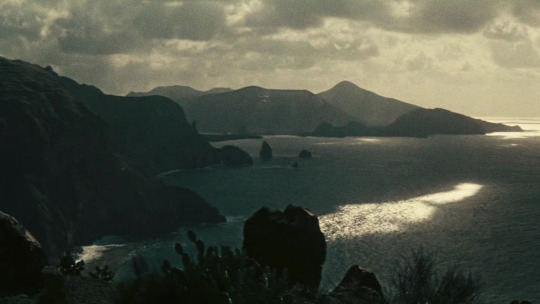
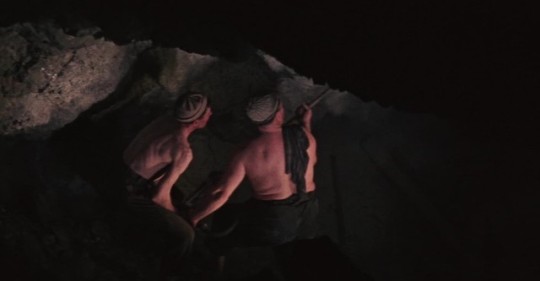

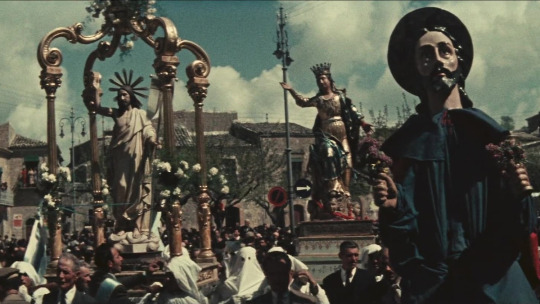
Special mention: Vittorio De Seta's 1955 documentaries.
In 1955, De Seta released six(!) documentary shorts: Islands of Fire, Surfarara, Easter in Sicily, The Age of Swordfish, Sea Countrymen, and Golden Parable. Stunning as individual films, but taken as a group, they become a meditation on the violence of living off the land and the endless cycle of life and death. Acting as director, editor, and cinematographer, De Seta marries ethnography and anthropology with artistry, creating bite-sized, miraculous films that immortalize life and labor in rural Sicily. The cinematography alone is jaw-dropping. Whether the films chronicle the Stromboli volcano, ancient religious rituals, a day of work in sulfur mines, harvesting grain, or the life of a fisherman, they are immersive and fleeting. The longest of these films is 12 minutes, and they all feel like dreams. Stunning stuff.
All six of these films, and more of De Seta's work, are streaming on the Criterion Channel.

Honorable mentions (in alphabetical order): After Yang (dir. Kogonada, 2021); Akira (dir. Katsuhiro Otomo, 1988); Asako I & II (dir. Ryusuke Hamaguchi, 2018); Beverly Hills Cop (dir. Martin Brest, 1984); The Boy Friend (dir. Ken Russell, 1971); Carnal Knowledge (dir. Mike Nichols, 1971); Dogfight (dir. Nancy Savoca, 1991); Game Night (dir. John Francis Daley and Jonathan Goldstein, 2018); Girlhood (dir. Céline Sciamma, 2014); The Great Piggy Bank Robbery (dir. Robert Clampett, 1946); Heat (dir. Michael Mann, 1995); Italianamerican (dir. Martin Scorsese, 1974); Kajillionaire (dir. Miranda July, 2020); Linda Linda Linda (dir. Nobuhiro Yamashita, 2005); Mean Streets (dir. Martin Scorsese, 1973); Night of the Living Dead (dir. George A. Romero, 1968); Pink Flamingos (dir. John Waters, 1972) Saving Face (dir. Alice Wu, 2004); Shake! Otis at Monterey (dir. D. A. Pennebaker, Chris Hegedus, and David Dawkins, 1987); Shiva Baby (dir. Emma Seligman, 2020); Three Thousand (dir. asinnajaq, 2017); Videodrome (dir. David Cronenberg, 1983); When the Day Breaks (Amanda Forbis and Wendy Tilby, 1999); While You Were Sleeping (dir. Jon Turteltaub, 1995); Windy Day (dir. John Hubley and Faith Hubley, 1968); Wings of Desire (dir. Wim Wenders, 1987); Your Face (dir. Bill Plympton, 1987)
And finally, some miscellaneous viewing stats:
First movie watched in 2023: Akira (dir. Katsuhiro Otomo, 1988)
Final movie watched in 2023: The Devil Wears Prada (dir. David Frankel, 2006)
Least favorite movie: Blonde (dir. Andrew Dominik, 2022)
Oldest movie: The Impossible Voyage (dir. Georges Méliès, 1904)
Longest movie: The Ten Commandments (dir. Cecil B. DeMille, 1956 - 220 mins.)
Shortest movie: Premonitions Following an Evil Deed (dir. David Lynch, 1995 - 1 min.)
Month with the most viewings: January (35)
Month with the fewest viewings: May (5)
First movie from 2023 seen: Rye Lane (dir. Raine Allen-Miller, 2023)
Total movies: 231
Movies! They're good. Sometimes. Happy new year, friends!
#this is not an ad for the criterion channel i promise#jeanne dielman 23 quai du commerce 1080 bruxelles#chantal akerman#the ascent#larisa shepitko#the big snit#richard condie#vagabond#agnès varda#a.i. artificial intelligence#steven spielberg#humanity and paper balloons#sadao yamanaka#mississippi masala#mira nair#lingua franca#isabel sandoval#the blue angel#josef von sternberg#time piece#jim henson#vittorio de seta#islands of fire#surfarara#golden parable#easter in sicily#the age of swordfish#sea countrymen#sometimes elliott watches movies#year in review
17 notes
·
View notes
Text
Movie Monday - Nov 16th, 2020
"My Favorite Foreign International Films"

So something I learned earlier this year is the Academy Awards category, "Best International Fim" - previously "Best Foreign Language Film" is somewhat flawed.
I read up on the category/topic more during the 2020 Academy Awards when Parasite had a breakthrough year.
First off - Why the name change?
Well, in the broadest aspects the word "Foreign" can be considered Politically Incorrect - by labeling an entire film - a piece work, or an entire film crew as foreign you are basically saying they are "Other" which could be construed as lesser. Renaming the category to "Best International Film" is a step to seem more inclusive as films should be a universal experience - the category is after all a celebration of World Cinema.
The name change however did not change any of the qualifications in regards to reaching the award ceremony - such qualifications as:
The featured language in the movie needs to predominantly Non-English - so this majorly affects countries like Australia, New Zealand, Canada, and the United Kingdom - you know, because if you speak English you must be American - you have no added culture.
This rule/mindset screwed over Nigeria, a country whose official language is English due to its past British rule. Nigeria submitted the film Lionheart, THE COUNTRY'S FIRST EVER SUBMISSION, to the 2020 Academy Awards and was disqualified as the English language was widely used in the film.
So to recap - An African country was disqualified from even being considered a nominee at the Oscars because their Official Language was not "Foreign" enough.
Now, just because English is your official language does not automatically exclude you - Australian, Canadian, and the UK film makers have made Non-English films just so they could be considered for the category.

Another aspect of a International Film category is that Each Country Chooses just ONE movie to represent their country - Only ONE. When it comes time all the International Films are finally whittled down to just 5 nominees for the Oscar ballot.
For most countries, like Italy (14 Oscar Wins - 28 nominations) and France (37 Oscar nominations - the most of any country, and 12 Oscar wins), this does not pose any issues as they are very open in regards to their selection process.
But when you consider countries like Russia, China, or Iran where creativity is censored or suppressed you are mostly likely not getting the best of the best.
Due to the censorship some people suggest creating an International panel to assist with each country's film selection, but how much power do we provide this panel and how will this affect countries like France and Italy that do not seem to have censorship issues?
These are some of the main issues the International Film category faces currently.

So now that we talked shop - it is time for me to talk about my personal favorites - I will note all these films are must sees in my book, but do not necessarily garnish repeat viewings.
Also, I am leaving out Amélie (2001), a true personal favorite, off the list because everyone and their hypoallergenic service dogs loves the film as well.
Without further ado...
In Order of the Rising Sun:
Hunt for the Wilderpeople (2016)
Origin: New Zealand
Language: English
Director: Taika Waititi
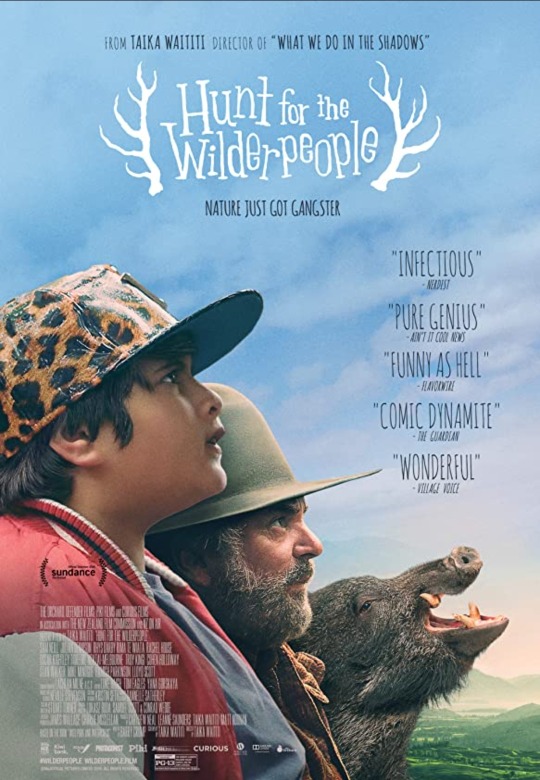
Synopsis:
A national manhunt is ordered for a rebellious kid and his foster uncle who go missing in the wild New Zealand bush.
Kung Fu Hustle (2004)
Origin: Hong Kong, China
Language: Chinese
Director: Stephen Chow

Synopsis:
In Shanghai, China in the 1940s, a wannabe gangster aspires to join the notorious "Axe Gang" while residents of a housing complex exhibit extraordinary powers in defending their turf.
Dogtooth (2009)
Origin: Greece
Language: Greek
Director: Yorgos Lanthimos

Synopsis:
Three teenagers live isolated, without leaving their house, because their over-protective parents say they can only leave when their dogtooth falls out.
Cinema Paradiso (1988)
Origin: Italy
Language: Italian
Director: Giuseppe Tornatore
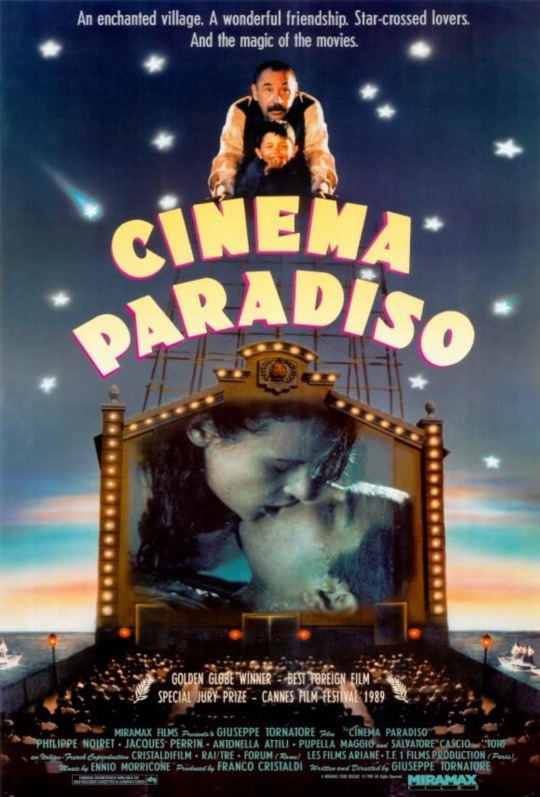
Synopsis:
A filmmaker recalls his childhood when falling in love with the pictures at the cinema of his home village and forms a deep friendship with the cinema's projectionist.
Raw (2016)
Origin: France
Language: French
Director: Julia Ducournau

Synopsis:
A young woman, studying to be a vet, develops a craving for human flesh.
Abre Los Ojos (1997)
Origin: Spain
Language: Spanish
Director: Alejandro Amenábar

Synopsis:
A very handsome man finds the love of his life, but he suffers an accident and needs to have his face rebuilt by surgery after it is severely disfigured.
Relatos Salvajes (2014)
Origin: Argentina
Language: Spanish
Director: Damián Szifron

Synopsis:
Six short stories that explore the extremities of human behavior involving people in distress.
So... There you go, Happy Viewing
#Movie Monday#52 on 20#Favorite Foreign Films#Favorite International Films#Hunt For the Wilderpeople#Kung Fu Hustle#Dogtooth#Raw#Cinema Paradiso#Abre Los Ojos#Relatos Salvajes
19 notes
·
View notes
Text
Initial Thoughts on Flight PS-752
Today I woke up to western governments revealing that they now believe that the Ukrainian airliner shot down over Tehran was, either deliberately or accidentally, destroyed by Iran’s own defense systems.
My initial thoughts were: that’s bullshit. No flight information has yet been released, and a Ukrainian investigation, which is open to several potential causes, hasn’t even had a chance to begin.
However having seen the footage released by the NYT, showing a missile clearly intercepting the airliner, I began worrying about something else: if this was indeed a case of missile interception, then western media is going to take advantage of the technical illiteracy of the public when it comes to weapons systems to push several unfounded narratives.
Confusion
Logging in to Twitter I saw several prominent members of the international communist movement expressing deep, and understandable, confusion over the narratives surrounding the shoot-down. I don’t mean to speak down to anyone, and my only expertise in this area is having programmed missile flight behaviors for some video games based on some technical specs, hardly an engineering degree. Still I want to help clear up some confusion.
Several people were confused about whether the narrative that was developing had anything to do with the missile salvos that were launched against US bases in Iraq. Some questioned how a missile from the launch sites could have intercepted an airliner hundreds of miles away in Tehran, a long way away from Iraq. Others questioned how an Iranian military, which showed such incredible precision in targeting uninhabited areas in Iraq, could make a move so imprecise as downing a friendly aircraft.
This is because the missiles involved in these two separate incidents are completely different. The Surface-to-Surface missiles fired at the Iraqi bases were likely Fajr-3 ballistic missiles, which have an inertial navigational system. Such a system is usually calibrated at the launching site, and is able to detect changes in the missile’s own speed and trajectory, often using an altimeter to detect the distance from the ground, and thereby change its direction once it has entered the upper atmosphere and strike a target. Such a system cannot hit moving targets or detect what is ahead of it. Some modern systems issue course corrections via GPS, giving greater accuracy, but they still cannot truly change behaviour once they have been fired.
No one is claiming that such a missile hit flight PS-752, as even if it was travelling along the missile’s ballistic trajectory, which it wasn’t, the chances of the two objects hitting each other at high speed is a million-to-one.
On the other hand, the missile that hit Flight PS-752 would have had a totally different guidance system. It would either have used a passive infrared system, a semi-active radar system, or an active radar system. All modern AA missiles use one or another of these systems. Passive infrared picks up on the “heat signature” of an aircraft and follows that. Semi-active radar means the missile is sent data from a radar set on the ground and intercepts the target based on that. Active radar missiles have their own miniaturised radar system that can send and receive signals and detect aircraft itself.
All of these systems are fired at very high speeds to attack planes at high altitude and speeds. Passive infrared and active radar missiles are also considered “fire and forget” missiles, as they continue to pursue their target even after the operator of the system has directed their attention elsewhere. Combined, this means that it’s perfectly reasonable that the Iranian military could conduct both a very careful surface-to-surface attack without any civilian casualties, but also mistakenly conduct a surface-to-air attack that tragically killed hundreds. Once an AA missile is fired, it can’t typically be called off.
Deliberate Misinformation
None of this is to suggest that the US and Canadian narratives should be believed as they are also full of conjecture, half-truths and outright lies. Several sources claimed that the US had direct intelligence from the airliner, or that US intelligence knew for certain the type of missile involved and the circumstances that lead to the downing.
Without making use of a psychic, the US could not possibly know what kind of radar signature “locked on” to the Ukrainian flight. They didn’t have some sort of direct data uplink to the cockpit, nor do civilian flights have passive radar arrays which can detect missile launches, as the reports seem to suggest. The overall impression I get is that the sources are trying to mislead the public using a hollywood understanding of how missiles work.
The US and Canadian sources say with a great degree of certainty that the missiles fired were two Russian-made Tor-M1 missiles (SA-15 “Gauntlet” missiles in NATOspeak). These are semi-active radar missiles, which are relatively small and fast. They hit the airliner in an engine, causing a fire, after which point the plane turned around and attempted to land.
However this is based entirely on two blurry cellphone videos. One purports to show a small piece of a Tor missile amidst the wreckage, the other shows a missile being fired at an airliner, hitting it.
The thing is, it’s entirely believable that this is the case. A Tor missile would strike a plane in a similar manner. It would be unlikely to cause catastrophic damage due to its small size. It would likely have a similar linear flight path compared to the “snaking” flight path of an Infrared missile. The discrepancies in the narrative are about the number of missiles (US sources say 2, the video seems to show 1 unless they are close together), and the location of the hit (a radar guided missile is more likely to hit the centre of mass - ie. the fuselage, rather than an engine, which is more commonly targeted by Infrared).
This distinction is somewhat important as depending on the guidance system it rules out the potential for other actors in the region, say foreign agents, downing the plane. A Tor would be too large to covertly operate, whereas small infrared missiles, such as the infamous FIM-92 “Stinger,” can and have been used in CIA operations in the region before. I don’t personally believe this story (if the US wanted a false-flag event there would have been many better options), but it’s an example of a narrative that can’t be ruled out.
What is more unbelievable is that western sources can report on such things with any degree of certainty. Iran has allowed a civilian investigation by Ukraine to continue, and so surely any conclusions must be left up to them. Iran has declined to hand the black box from the aircraft, a key piece of evidence, over to the US, but seeing how the US has seized upon the opportunity to push a warmongering narrative, that seems completely reasonable.
I suppose the point of this article is to warn against using “technical” reasons as to why a particular narrative is believable or unbelievable. It’s entirely believable that Iran mistakenly shot down an airliner, just as the US shot down Iran Air Flight 655 in 1988, although that incident was much more negligent. If we do go to war over this, then it won’t be for “technical” reasons; it will be because the US and Canada want to go to war, and the deaths of 62 Canadians can be easily used in a cynical outpouring of international “outrage” over so-called Iranian negligence. This was a tragedy, caused by the US more so than the operators of the missile that probably downed the flight, as Iranian defense certainly wouldn’t have made such a mistake if the US hadn’t increased tensions through a series of illegal killings. The international communist movement needs to spend less time focusing on technical details about western media narratives, as these can make us lose the forest for the trees. The focus should be on not letting warmongering media spin civilian deaths as a justification for further killing.
8 notes
·
View notes
Text
haim broken leg
This story was originally published March 3, 1989 about Haim's role in the fim "Dream a Little Dream."
LOS ANGELES Teen actor Corey Haim is intent on doing whatever he wants to these days.
He smokes three packs of cigarettes a day, has mostly older friends and wreaks havoc upon his mother whenever he can.
Haim also co-stars as Dinger in "Dream a Little Dream," which opens today in Oklahoma City.
As Dinger, Haim portrays the best friend of Bobby Keller, played by real-life friend Corey Feldman.
Four days before filming began for the movie, Haim broke his leg.
Instead of the incident harming his chances of being in the movie, it actually enhanced his role and made it bigger, he said. The broken leg was written into the script, and Haim hobbled around with a cane.
Haim's first explanation for his broken leg was a bit exaggerated: "She (Haim's mom) got mad at me one day and took a hammer and went crack!" What really happened was Haim's mom was riding on his Moped and crashed with him on the back.
Haim lives with his mom, who also is his manager. He said he likes to wake her up in the middle of the night by shining two flashlights in her eyes and making a train sound.
One night he put on a mask and walked into her room with a butterfly knife just to scare her. Evidently he did, because, to his surprise, she called the 911 emergency phone number for help.
Wearing a black beret, black T-shirt with "MAMBO" written across the front and a black and white checked vest, Haim said, "I'm just a weird kid."
"All day yesterday I was just in a room, really quiet like this (he acts reserved). I'd go like this and look around. (I) start getting really paranoid for no reason, just about if, like, if Corey Feldman's giving me the evil eye, Meredith (Salenger) is, like, looking at me, I hope.
"I'm sitting here, and out of the clear blue I just go "shiggy-rock-jet-dawg.' I just start doing these things like right, and just, and just start calling these things out that mean nothing."
Haim said he and Dinger are similar in some ways.
"There's a lot of things that are the same that I do," he said, "but there's a lot of things that I also made up. That's why me and Marc (Rocco, director of "Dream a Little Dream') are doing a couple more movies after this, together. And I will only try to do movies with Marc now."
Although filled with energy and prone to pranks, Haim has admirers, including Rocco.
"They're (Feldman and Haim are) both tremendously talented," Rocco said, "but you have to tell them that the camera's rolling to get them to rehearse.
"Haim I think he's an amazing talent. He's a bundle to deal with because he just I never remember having that much energy," Rocco said, adding that Haim was fun.
"Haim scares you to death. He shows up. "What scene are we doing? I didn't read it.' " Fifteen minutes later, Haim has looked at the script and memorized his part, and his scene is finished in two or three takes, Rocco said.
Haim had more of a supporting role in "Dream a Little Dream," but Haim said he didn't mind.
"I can do a movie where I have one line to say," he said, "but it has to be the most quality line in the world."
"This part wasn't big at all, but it was quality." He later said "Dream a Little Dream" was the brain, body-switching movie a lot of people had been trying to make.
Haim said there are some things he misses due to his career choice of acting.
"I miss hockey. I miss Canada," he said. "I miss everything to an extent. I can take it two ways. I can look back and regret what I didn't do, or I could just grow up real quick out here."
Haim also said he wants to act in a part that is powerful.
"I want to do something like Dustin Hoffman did in "Rain Man.' I mean, I could pull something like that off, I think.
"I want to do something so powerful that it blows, like, everybody away."
4 notes
·
View notes
Photo
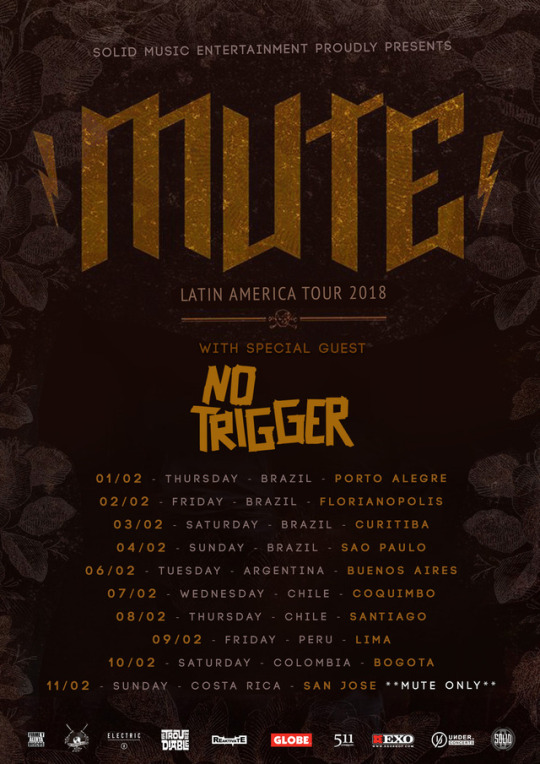
Essa semana nós tivemos a chance de conversar com uma grande banda canadense de Punk Rock, a banda MUTE. Nessa entrevista, a banda comenta um pouco sobre as expectativas para a turnê na América do Sul, sobre o processo de gravação do álbum “Remember Death” e sobre a cena punk canadense atualmente.
MUTE é uma banda canadense de Punk Rock fundada em 1998, a banda possui 4 álbuns de estúdio e 1 EP na carreira e conta com influências sonoras de bandas como Satanic Surfers, Strung Out, Children of Bodom, No Fun At All e Pennywise. MUTE vem ao Brasil em Fevereiro ao lado da banda No Trigger com uma turnê sul-americana passando por Porto Alegre, Florianópolis, Curitiba e São Paulo.
Antes de qualquer coisa gostaríamos de dizer que estamos muito feliz e honrados pela oportunidade e gostaríamos de agradecer a confiança que a Solid Music tem depositado em nós e também ao apoio de todos vocês que seguem e compartilham nossas postagens!
Mas agora vamos ao que importa, esperamos que vocês gostem da entrevista e pra quem quiser, a entrevista original em inglês vai estar no fim do post.
Respondido por Alexis Trépanier (Guitarrista):
We Are Fearless: Como vocês se sentem sobre voltar para o Brasil? O que você espera para esta turnê? O que podemos esperar de todos vocês?
Alexis Trépanier: Nos sentimos muito entusiasmados por voltar ao Brasil! Qualquer viagem à América Latina é uma ótima fonte de entusiasmo para nós. Estamos ansiosos para experimentar mais uma vez a paixão ilimitada dos fãs brasileiros!
WAF: Como foi o processo de gravação e composição do "Remember Death"? Como este álbum é diferente dos últimos musicalmente falando?
Alex: O processo de fazer "Remember Death” foi longo e cansativo. Passamos muito tempo na fase de pré-produção, registrando nossas próprias demonstrações no espaço de ensaio. Nós confiamos nesses demos para obter todos os detalhes certos, não importa quão pequeno e trivial. Mais tempo foi dedicado para elaborar os vocais e letras também. Ter o nosso próprio equipamento de gravação realmente nos ajudou a conseguir as músicas prontas como poderiam ser antes de realmente ir para o estúdio. Eu não acho que haja diferença importante e óbvia entre o último álbum e o anterior. As mudanças são muito mais sutis. Seja adicionando alguns instrumentos menos tradicionais para apimentar algumas músicas, ou simplesmente variando os tempos das músicas um pouco mais do que antes, então tudo não é tocado exatamente na mesma velocidade. O diabo está nos detalhes.
WAF: Desde o lançamento do primeiro álbum "Blueprints", qual foi a maior mudança no som da banda?
Alex: Para mim, é a qualidade da escrita da música. Pode soar como um elemento vago e intangível, mas não sei como descrevê-lo. Do “The Raven” em diante, nós ficamos muito melhores.
WAF: Qual foi a maior influência para começar a banda e qual a sua fonte de inspiração atual para continuar fazendo música desde o início?
Alex: Bom, eu não estava na banda no início, mas imagino que foi a mesma motivação que me fez entrar em uma banda em primeiro lugar. O desejo de tocar a música que amamos e tocar nossa própria música. Os motivos para continuar são os mesmos que quando começamos.
WAF: Qual foi a maior conquista que vocês já conseguiram como uma banda? E o que é mais difícil sobre estar em uma banda?
Alex: Eu acho que nossa maior conquista é que fomos bem-sucedidos sem ter comprometido nossa música. Teria sido fácil mudar nosso som para algo mais popular e pegar um atalho para ficar maiores dessa maneira, mas nunca a consideramos. Forjamos nosso próprio caminho, em nossos próprios termos.
WAF: Qual foi seu show favorito até agora, por quê? E qual é a sua música favorita para tocar ao vivo?
Alex: Isso é difícil... há tantos incríveis. Nós poderíamos provavelmente fazer os melhores 5 melhores shows apenas com a América do Sul! Acho que não posso simplesmente escolher um... São Paulo em 2014, Bogotá em 2014, México DF em 2014, primeira vez em Tóquio em 2015... Eu poderia continuar para sempre. A música favorita para tocar é provavelmente o “Bates Motel”, pois é uma das músicas que obtém a melhor reação da multidão.
WAF: A banda começou no Canadá certo? Como foi a sua cena local no momento em que a banda foi formada? Como está a cena agora? Há alguma banda local que vocês querem nos mostrar?
Alex: Isso mesmo, somos da Cidade de Quebec, Canadá. Quando começamos, há mais de 15 anos, a cena era muito boa. Tinham muitos shows o tempo todo e muitas pessoas iam á esses shows. Não apenas de bandas da Epitaph/Fat Wreck, mas também bandas locais. A maioria dos shows era realmente bem frequentada e as multidões faziam parte disso. Infelizmente, esses dias já se foram. A maioria das pessoas que você costumava ver em shows raramente aparecem agora, e eles não foram substituídos por fãs mais jovens. Conseqüentemente, os shows ficaram menores. A menos que seja um grande festival, é muito mais difícil atrair pessoas em shows punk. De qualquer forma, ainda existem algumas bandas da nossa área carregando a tocha. Na verdade, temos um show em algumas semanas com Go Great Guns e Our Darkest Days, que todos vocês devem verificar!
WAF: Há algo que vocês querem dizer a todos os seus fãs no Brasil?
Alex: É aqui que falar português seria útil agora? Vamos apenas dizer que não podemos esperar para ver todos vocês maravilhosos fãs brasileiros no show. Prepare-se!!
Siga MUTE em:
https://web.facebook.com/mutepunk?_rdc=1&_rdr
https://twitter.com/Mutepunkrock
https://www.instagram.com/mutepunk/
———————————————————————————————-
This week we had the chance to talk to a great Canadian Punk Rock band, the band MUTE. In this interview, the band comments a little on the expectations for their tour in South America, about the process of recording the album "Remember Death" and about the Canadian punk scene currently.
MUTE is a Canadian Punk Rock band founded in 1998. The band has 4 studio albums and 1 EP in their careers and has sound influences from bands such as Satanic Surfers, Strung Out, Children of Bodom, No Fun At All and Pennywise. MUTE comes to Brazil in February alongside No Trigger with a South American tour going through Porto Alegre, Florianópolis, Curitiba and São Paulo.
First of all we would like to say that we are very happy and honored by the opportunity and would like to thank the trust that Solid Music has placed in us and also to the support of all of you!
But now we go to what matters, we hope you like the interview:
Answered by Alexis Trépanier (Guitarist):
We Are Fearless: How do you guys feel about coming back to Brazil? What do you expect for this tour? What we can expect from you all?
Alexis Trépanier: We feel very excited about coming back to Brazil! Any trip to Latin America is a great source of excitement for us. We're looking forward experience once again the boundless passion of Brazilian fans!
WAF: How was the recording and writing process of “Remember Death”? How this album is different from the past ones musically speaking?
Alex: The process of making “Remember Death” was a long and draining one. We spent a lot of time in the preproduction phase, recording our own demos at the rehearsal space. We relied on these demos to get every single detail just right, no matter how small and trivial. More time was spent crafting the vocal parts and lyrics too. Having our own recording equipment really helped us getting the songs as ready as they could be before we hit the real studio. I don't think there's any major, obvious difference between the last album and the one before. The changes are a lot subtler. Weather it is adding a few less traditional instruments to spice up some songs, or simply varying the tempos of the songs a little bit more than before so everything is not played at the exact same speed. The devil is in the details.
WAF: Since the release of the very first album “Blueprints”, what was the biggest change in the sound of the band?
Alex: To me it's the quality of the song writing. It may sound like a vague and intangible element, but I don't know how else to describe it. From The Raven and onwards, we just got so much better.
WAF: What was the biggest influence to start the band and what’s your current inspiration source to keep making music since the beginning?
Alex: Well, I wasn't in the band at the very beginning, but I imagine it was the same motivation that made me join a band in the first place. The desire to play the music that we loved and to play our own music. The reasons to keep going are the same as when we started.
WAF: What was the biggest achievement that you guys ever achieved as a band? And what’s the hardest thing about being in a band?
Alex: I think our biggest achievement is that we've been successful without having compromised our music. It would have been easy to change our sound to something more popular and take a stab at getting bigger that way, but we never even considered it. We have forged our own path, on our own terms.
WAF: What has been your favorite show to date, why? And what’s your favorite song to play live?
Alex: That's a tough one... there are so many amazing ones. We could probably do a top 5 best shows just with South America! I think I can't just pick one... Sao Paulo 2014, Bogota 2014, Mexico DF 2014, first time in Tokyo 2015... I could go on forever. Favorite song to play is probably “Bates Motel” as it is one of the songs that gets the best reaction out of the crowd.
WAF: The band started in Canada right? How was your local scene at the time the band was formed? How’s the scene now? There’s any local band you guys want to show to us?
Alex: That's right, we're from Quebec City, Canada. When we started, over 15 years ago, the scene was very good. There was a lot of shows all the time and a lot of people came to those shows. Not just Epitaph/Fat Wreck bands but local bands too. Most of the shows were really well attended and crowds were really into it. Unfortunately, those days are long gone. Most of the people you used to see at shows very rarely show up now, and they haven't been replaced by younger fans. Consequently, the shows have gotten smaller. Unless it's a big festival, it's a lot tougher to draw people at punk shows. Anyway, there are still a few bands from our area carrying the torch. We actually have a show in a few weeks with Go Great Guns and Our Darkest Days which you all should check out!
WAF: Is there anything you guys want to say to all your fans in Brazil?
Alex: This is where speaking Portuguese would be useful now would it? Let's just says that we can't wait to see all of you wonderful Brazilian fans at the show. Get ready!!
Follow MUTE in:
https://web.facebook.com/mutepunk?_rdc=1&_rdr
https://twitter.com/Mutepunkrock
https://www.instagram.com/mutepunk/
#MUTEPUNK#MUTE#No Trigger#Punk Rock#Solid Music#Interview#WAF#we are fearless#we are fearless br#south america tour
1 note
·
View note
Text
XII Rio Harp Festival encerra no Rio com um público de mais de 20.000 pessoas.
O XII Rio Harp Festival-Música no Museu encerrou no Rio de Janeiro a edição 2017 ,com mais de 20.000 espectadores que assistiram sua programação de 138 concertos, foram realizadas de 3 a 5 apresentações diárias, algumas extras para atender a grande demanda do público.
O evento contou com a participação de 100 músicos, sendo 32 harpistas de 24 países, que apresentaram-se no final de abril no CCBB-São Paulo e em maio nos espaços culturais e pontos turísticos do Rio de Janeiro e que se expande para a Europa com concertos em cidades de Portugal e Madrid e Espanha encerrando-se no dia 3 de julho próximo.
Segundo os próprios harpistas participantes tornou-se o maior festival de harpas do mundo não só pelo número de concertos como também pela sua duração.
Além do Rio, outras cidades brasileiras entraram no circuito do festival, que cresce a cada edição, confirmando a potência de um dos mais delicados e antigos instrumentos musicais. Talvez seja questão de tempo para que, assim como a série Música no Museu, possa atingir todo o Brasil.
PÚBLICO:
Formado por um público eclético e curioso, o festival teve uma lotação inédita, e, em muitas sessões esgotadas foi necessário retornar no dia seguinte a fim de não perder as suas atrações.
Todos os tipos de harpas: clássicas tocadas nas orquestras, célticas, koto (japonesa), indianas, kora (africana), paraguaia, colombiana,elétrica, llhanera e até a de cristal do harpista Athy e única no mundo tocadas de formas distintas, em pé, sentadas no chão etc foram apresentadas e os ritmos mais variados: desde o barroco e clássico até o heavy metal passando pelo samba, chorinho, ritmos latino-americanos,irlandeses, rock, jazz, tango e fado.
GRUPOS:
Artistas de vários países e muitos do Brasil mostraram através do instrumento as músicas de suas regiões, além disso o evento promoveu vários encontros musicais, onde jovens artistas e harpistas consagrados se reuniram no palco, muitos desses jovens são de comunidades e projetos sociais e tiveram a oportunidade de mostrar seu talento em um festival de grandes proporções.
Demonstrando a versatilidade musical do instrumento, diferentes escolas e estilos mostraram ao público que a harpa não se limita à música clássica: gêneros como música africana, celta, indiana, irlandesa até o pop e o rock estiveram presentes no festival.
.
Enquanto isso as orquestras de projetos sociais tiveram a oportunidade de subir ao palco com as estrelas nacionais e internacionais, foram elas: a Camerata do Uerê, Coletivo Músicos da Baixada, e o Conjunto de Violoncelos da Ação Social pela Música.
Os locais do evento foram também uma atração à parte; os concertos foram realizados nos cartões postais da cidade como o Corcovado, Jockey Club, Iate Clube, Ilha Fiscal e os centros culturais como: Centro Cultural Banco do Brasil, o Centro Cultural Justiça Federal, o Museu do Exército e a Biblioteca Nacional, e a edição deste ano também incluiu o AquaRio.
The RioHarpFestival is ending its XII edition - 2017 - .
More than 20.000 people were present at 138 concerts.
We have done , at least, 3 or 5 dayly performances and some extra presentations, too.
In this event, 100 musicians have participated and 42 harpers from 24 different countries.
This HarpFestival began in April, in S. Paulo and in May, here in Rio de Janeiro, in a lot of cultural and touristic places. The HarpFestival is spread in Europe, as in Lisbon - Portugal, and in Madrid - Spain. It finishes in July, the 3rd.
As the harpists have said, this Festival is the greatest one all over the world on account of its numbers of concerts and its length of time.
On the other side, another Brazilian cities were included in this event , and so, they confirm the exceptional importance of this ancient and fine instrument, the Harp.
We suppose that in the near future the HarpFestival will be expanded all whole Brazil.
All the countries as Japan Italy, Chile, EUA, Canada, Colombia, Peru, South Africa, Lebanon, Argentina, India, Belgium, Spain, Netherland, Mexico, Paraguay, Ireland, France, Croatia, Austria and Brazil were represented by their best musicians and artists of various instruments.
THE AUDIENCE
We had a curious and eclectic public and sometimes these same people had to return on the day after, because all the tickets were sold out in the present moment they wanted.
THE INSTRUMENTS
We have Pedal-Harp, Celtic, Paraguayan , Indian, Chilean Colombian , Mexican and Peruvian Harps, Kora (African), Electric, Llanera Syntetizers and one Harp made of cristal presented by Athy, from Argentina.
We had a new formation as " Tamburello - Drum" and Harp presented by Massimo Cusato ( percussion) and Giuliana De Donno ( Harp), from Italy. Otherwise we have had singers, pianists, a cuatrist, flutists, cellists, a trumpetist, percussionists, violinists, bassist, and guitarrist.
THE STYLES
About the styles, they were varied, since Classic, Baroque, Romantic, until Heavy -Metal, Samba, Chorinho, Latin-American, Irish, Scottish, Tyrolean, Folks, Ethnic, Rock, Jazz, and Tango.
THE GROUPS
The artists through thier instruments have showed the characteristics of their own regions. Young artists from the Communities as Camerata Uerê, Coletivo Músico da Baixada, and Conjunto de Violoncelos da Ação Social pela Música have had the opportunity to exhibit their talents in a huge Festival.
ABOUT THE PLACES
They were special attractions: Corcovado, Jockey Club, Iate Club, Ilha Fiscal and cultural centers as Centro Cultural do Banco do Brasil ( CCBB), Centro Cultural da Justiça Federal, (CCJF), Museu do Exército, Biblioteca Nacional and a new very special place: AquaRio
0 notes